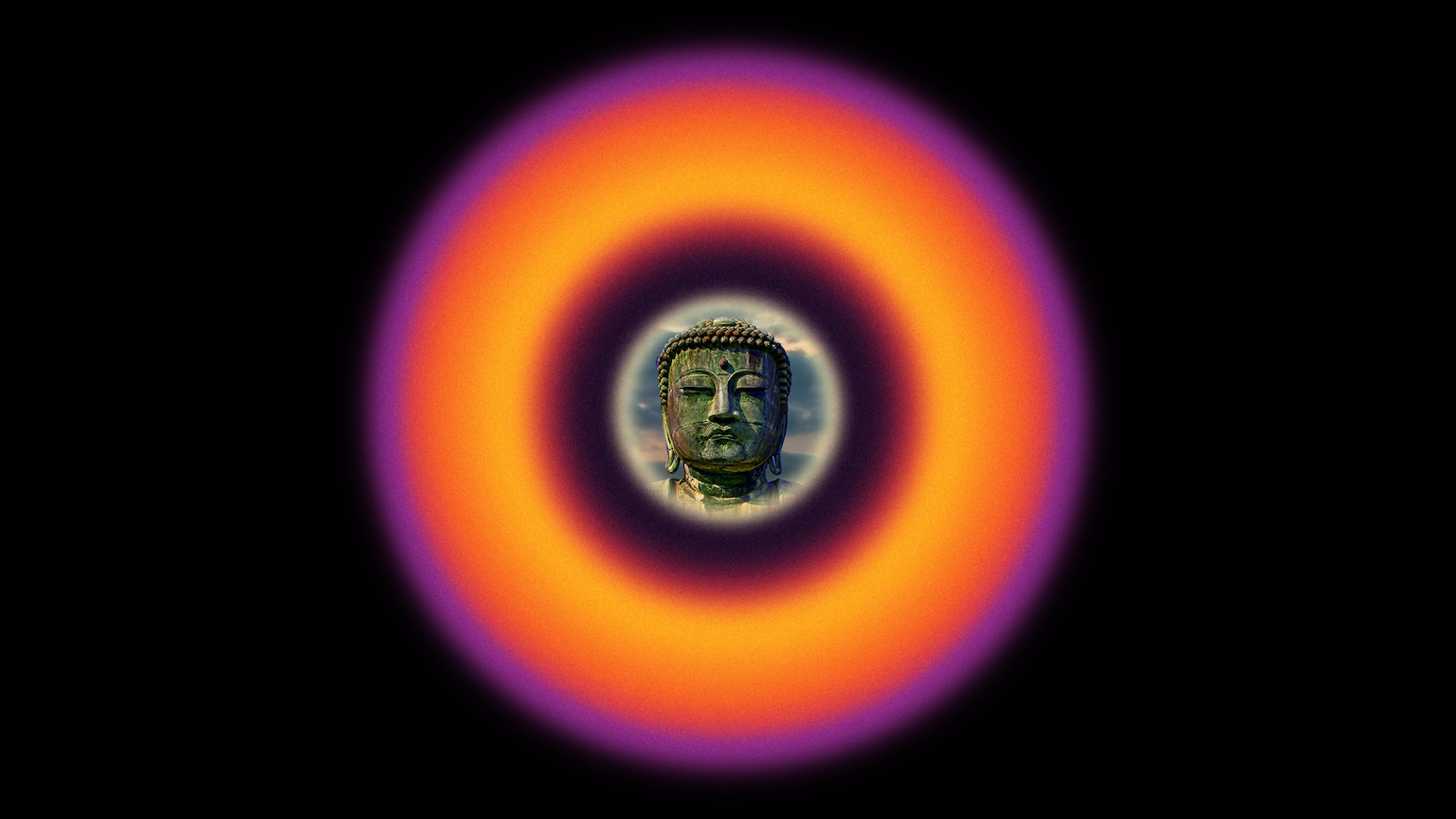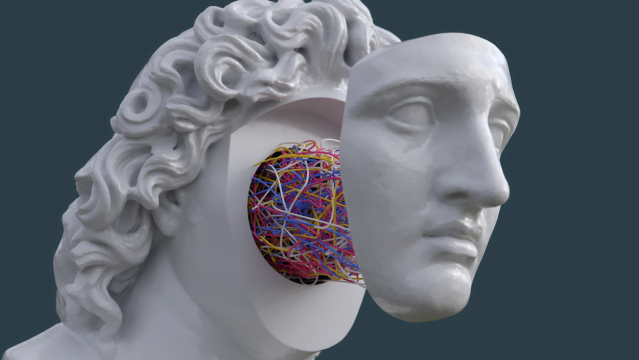How the brain’s left hemisphere “mesmerizes” us into misunderstanding reality

- The brain is divided into two hemispheres: The left hemisphere is designed to help us manipulate the world, the right hemisphere to see it all for what it is.
- In a similar way, philosophy and science have remained separate from each other. But any specialization is useless if it is cordoned off from the rest of knowledge.
- In his 2021 book, The Matter with Things, Ian McGilchrist argues that we need a new perspective from which to look at the fundamental building blocks of the cosmos.
This is an excerpt from the opening pages of The Matter with Things, a book which was published in November 2021 by Perspectiva Press. It is my attempt, using science and philosophy, to open our eyes to a world beyond everyday science and everyday philosophy. It argues that if we are wreaking havoc on ourselves and the world, and if our best intentions lead to paradoxical outcomes, it is because we have become mesmerized by a mechanistic, reductionist way of thinking, the product of a brain system which evolved not to help us understand, but merely to manipulate the world: that of the left hemisphere. We have become blind to what the subtler, more intelligent and more perceptive right hemisphere sees. Consequently we no longer seem to have the faintest idea who we are, what the world is, or how we relate to it. Indeed there is a sense in which we no longer live in a world at all, but exist in a simulacrum of our own making. Please read on.
“Yes, a key can lie for ever in the place where the locksmith left it, and never be used to open the lock the master forged it for.” — Ludwig Wittgenstein
This book is an attempt to convey a way of looking at the world quite different from the one that has largely dominated the West for at least three hundred and fifty years – some would say as long as two thousand years. I believe we have systematically misunderstood the nature of reality, and chosen to ignore, or silence, the minority of voices that have intuited as much and consistently maintained that this is the case. Now we have reached the point where there is an urgent need to transform both how we think of the world and what we make of ourselves; attempting to convey such a richer insight is the ambition of this book.
We have been seriously misled, I believe, because we have depended on that aspect of our brains that is most adept at manipulating the world in order to bend it to our purposes. The brain is, importantly, divided into two hemispheres: you could say, to sum up a vastly complex matter in a phrase, that the brain’s left hemisphere is designed to help us ap-prehend – and thus manipulate – the world; the right hemisphere to com-prehend it – see it all for what it is. The problem is that the very brain mechanisms which succeed in simplifying the world so as to subject it to our control militate against a true understanding of it. Meanwhile, compounding the problem, we take the success we have in manipulating it as proof that we understand it. But that is a logical error: to exert power over something requires us only to know what happens when we pull the levers, press the button, or utter the spell. The fallacy is memorialized in the myth of the sorcerer’s apprentice. It is hardly surprising, therefore, that while we have succeeded in coercing the world to our will to an extent unimaginable even a few generations ago, we have at the same time wrought havoc on that world precisely because we have not understood it.
This book, then, is about the nature of reality. It’s about how we are equipped by our brains to try to understand it, and what we can learn from that. It’s about the approaches that are available to us to gain an understanding of reality, given that equipment. It attempts, consequently, to give an account of reality that seems truer to the evidence than the one to which we have long been accustomed; one that is far-reaching in its scope, and consistent across the realms of contemporary neurology, philosophy and physics.
And from that follows an account of who we are, on which nothing less than our future depends.
What in particular I offer here is a new synthesis of philosophy and science which I believe is importantly, and excitingly, liberating to both parties. As a rule, philosophy and science go on as if the other did not exist. Scientists tend to see philosophy as a luxury they can’t afford to get involved with, a ball and chain that will slow them down in their race for the next discovery; philosophers to see science as somewhat beneath them, and in any case irrelevant to the ponderings of the mind on itself. But as the great physicist Erwin Schrödinger put it in Science & Humanism,
“it seems plain and self-evident, yet it needs to be said: the isolated knowledge obtained by a group of specialists in a narrow field has in itself no value whatsoever, but only in its synthesis with all the rest of knowledge and only inasmuch as it really contributes in this synthesis toward answering the demand, τίνες δὲ ἡμεῖς; ‘Who are we?’“
Here Schrödinger is remembering Plotinus, one of the greatest of Greek philosophers; but his point is of a contemporary relevance that it is impossible to overstate.
Seventy years on from Schrödinger’s pronouncement, specialization makes it even harder to expect more than a tiny handful of scientists and philosophers to be in a position to venture into a genuinely new understanding of their (in reality) common enterprise, one that has the potential hugely to enrich both parties. When any attempt is made to reach out a hand across the distancing void, it is almost invariably an exercise in reinforcing the status quo: the scientists telling the philosophers that they find only machinery, and the philosophers reflecting back to the scientists that a mechanistic view is the best option on offer. Since what you find is a product of how you attend, this is a more or less pointless exercise in making sure that both parties sink to the bottom in the shortest possible time.
Philosophy is engaged in weighing evidence so as to decide between conflicting ways of understanding the world, each of which has something to be said for it. This is why philosophy never ends. But what if, among the evidence, there were some way of recognizing a particular take on the world as – not just floating in a contextual void, but rather – the predictable result of paying a quite particular kind of attention to the world? And what if we happened to know a great deal about the evolutionary purposes, and the consequences, of such a way of attending, including what weight we should attach to its findings?
And what if such insights, gained from science, and explicated by philosophy, could be applied in turn to the science of mind itself? Then might we not begin to see a fertile symbiosis of philosophy and science, helping one another, each turn building on the next, to rise to a new, more truthful vision of who, indeed, we are?
Re-thinking some assumptions
At the core of the contemporary world is the reductionist view that we are – nature is – the earth is – ‘nothing but’ a bundle of senseless particles, pointlessly, helplessly, mindlessly, colliding in a predictable fashion, whose existence is purely material, and whose only value is utility. Neither Plotinus nor Schrödinger would have been impressed. I cannot remember a time when I thought this sounded at all convincing; and a lifetime’s thinking and learning has done nothing to allay my scepticism. Not only is it mistaken, I believe, but actively damaging – physically, to the natural world; and psychologically, morally, and spiritually to ourselves as part of that world. It endangers everything that we should value.
Reductionism can mean a number of things, but here I mean quite simply the outlook that assumes that the only way to understand the nature of anything we experience is by looking at the parts of which it appears to be made, and building up from there. By contrast I believe that the whole is never the same as the sum of its ‘parts’, and that, except in the case of machines, there are in fact no ‘parts’ as such, but that they are an artefact of a certain way of looking at the world. For this reason it is every bit as true that what we call the parts can be understood only by understanding the whole to which they belong. And with the reductionist outlook goes determinism, the belief that if we knew enough about the position and momentum of every particle in the universe we could predict everything that happens from here on in, including your every thought, desire and belief.
Even if contemporary physics did not demonstrate that this is an impossibility, there is a problem with this kind of argument. Reductionists and determinists unerringly fail to take account of the fact that their own arguments apply to themselves. If my beliefs are ‘nothing but’ the mechanical products of a blind system, so are all views, including those of the reductionist. If everything is already determined, the determinist’s tendency to embrace determinism is also merely determined, and we have no reason to take it seriously (since we are all determined either to believe it or not already). As the philosopher Hans Jonas observed, there is an unspoken hierarchical principle involved:
“the scientist does take man to be determined by causal laws – but not himself while he assumes and exercises his freedom of enquiry and his openness to reason, evidence and truth. His own working assumptions involve free will, deliberation, and evaluation as aspects of himself, but those qualities and capacities are stripped away from and denied to the human object or thing that he is inspecting…”
If it were not for the fact that this world-picture is mistaken, you might argue that we ought, nonetheless, to ‘man up’ and accept it. But it is, as I hope to demonstrate, massively mistaken. My aim is to show the reader the magnitude of the error, and its consequences. I say ‘show’, because I cannot, any more than anyone else, prove anything finally and irrefutably – the material with which we are dealing makes that impossible; but rather I wish to take my reader by degrees to a new vantage point, one built upon science and philosophy, from which, in all likelihood, the view will appear at the same time unfamiliar, and yet in no way alien – indeed rather the opposite. More like a home-coming. From there the reader must, of course, make up his mind for himself.
‘To put the matter in a nutshell’, wrote the philosopher Friedrich Waismann,
“a philosophical argument does more and does less than a logical one: less in that it never establishes anything conclusively; more in that, if successful, it is not content to establish just one isolated point of truth, but effects a change in our whole mental outlook so that, as a result of that, myriads of such little points are brought into view or turned out of sight, as the case may be.”
Such a whole shift of view, rather than the adjustment of a few points within a familiar landscape, is what I hope for my reader.
And that process must begin with the very idea of things. ‘The world is not just a set of separately existing localized objects, externally related only by space and time’, writes Tim Maudlin, Professor of Philosophy and Physics at NYU. ‘Something deeper, and more mysterious, knits together the fabric of the world.’ Indeed, according to Richard Conn Henry, Professor of Physics and Astronomy at Johns Hopkins, ‘to see the Universe as it really is, we must abandon our tendency to conceptualize observations as things’.
Reductionism envisages a universe of things – and simply material things at that. How these things are related is viewed as a secondary matter. However, I suggest that relationships are primary, more foundational than the things related: that the relationships don’t just ‘connect’ pre-existing things, but modify what we mean by the ‘things’, which in turn modify everything else they are in relationship with. That is because what we are dealing with are, ultimately, relations, events, processes; ‘things’ is a useful shorthand for those elements, congealed in the flow of experience, that emerge secondarily from, and attract our attention in, a primary web of interconnexions. I have nothing against things, provided we don’t see them as primary.
In our ordinary way of thinking, things must be established before there can be relationships, and so this about-turn should seem paradoxical; but as I shall explain, paradox very often represents a conflict between the different ‘takes’ afforded by the two hemispheres. However, we must also be prepared to find that, as Niels Bohr recognised, whereas trivial truths manifestly exclude their opposites, the most profound truths do not. This is itself a version of the realisation that what applies at the local level does not necessarily apply in the same way at the global level. The failure to observe this principle underlies some of the current misconceptions of both science and philosophy.
I believe that nowadays we live no longer in the presence of the world, but rather in a re-presentation of it. The significance of that is that the left hemisphere’s task is to ‘re-present’ what first ‘presences’ to the right hemisphere. This re-presentation has all the qualities of a virtual image: an infinitely thin, immobile, fragment of a vast, seamless, living, ever-flowing whole. From a standpoint within the representation, everything is reversed. Instead of seeing what is truly present as primary, and the representation as a necessarily diminished derivative of it, we see reality as merely a special case of our representation – one in which something is added in to ‘animate’ it. In this it is like a ciné film that consists of countless static slices requiring a projector to bring it back into what at least looks to us like a living flow. On the contrary, however, reality is not an animated version of our re-presentation of it, but our re-presentation a devitalized version of reality. It is the re-presentation that is a special, wholly atypical and imaginary, case of what is truly present, as the filmstrip is of life – the re-presentation is simply what one might call the ‘limit case’ of what is real. Stepping out of this world-picture and into the world, stepping out of suspended animation and back into life, will involve inverting many of our perhaps cherished assumptions.
This concept of the limit case is one I will recur to. I am using it to mean that what is essential to the phenomenon has in this case reached its minimum, without being actually extinguished. It should not be taken as typical, but as the very opposite. Thus, reverting to the example of relationships and the ‘things related’, relationship is the norm; isolation, if it could ever be wholly achieved (which it cannot), would be the limit case of interrelation. Or again, to continue the image of the ciné film: in the Newtonian universe, the natural state of any ‘thing’ is stasis. According to Newtonianism, motion is an aberration from this primal state of perfect inertia, requiring the equivalent of the projector (some energy conceived as added from outside) to set it going. However, nothing we know is in reality ever entirely static; and relative stasis, not motion, is the unusual circumstance that requires explanation. Stasis is, in other words, the limit case of motion, in which it approaches, but never completely reaches, zero. Motion, then, is not an unusual departure from stasis, but stasis an unachievable imaginary state, which in reality can be approached only as an asymptote.
Let me give a few further examples, which I grant may seem at first sight surprising, even nonsensical. We could start with our own thought processes and their expression in language. The explicit is not more fully real than the implicit. It is merely the limit case of the implicit, with much of its vital meaning sheared off: narrowed down and ‘finalised’. The literal is not more real than the metaphorical: it is merely the limit case of the metaphorical, in which the wealth of meaning is collapsed into a 1:1 correspondence for a useful, temporary, purpose.
More importantly, it’s the wider cosmos whose deep structure we are inclined to misunderstand. It may seem obvious that randomness is the primary condition and that order is an unusual phenomenon that emerges from (how?) and is supervenient on, that primary chaos. However, order is not a special case of randomness, but randomness merely the limit case of order, which is the universal norm. Indeed, true randomness is a theoretical construct that does not exist.
Complexity and simplicity are relative terms. However, complexity is surely, we imagine, a more unusual state of affairs arising out of the agglomeration of more simple elements – isn’t it? I believe that this is a mistake – one all too understandable, given our world view, but a mistake nonetheless. Rather, complexity is the norm, and simplicity represents a special case of complexity, achieved by cleaving off and disregarding almost all of the vast reality that surrounds whatever it is we are for the moment modelling as simple (simplicity is a feature of our model, not of the reality that is modelled). In keeping with this – and, don’t worry, right now this should seem crazy – inanimacy is better regarded as the limit case of animacy, something I will come to later in the book.
Potential is not simply all the things that never happened, a ghostly penumbra around the actual. The actual is the limit case of the potential, which is equally real; the one into which it collapses out of the many, as the particle is the collapse of a quantum field. (The particle is not more real than the field, rather it is a special case of the field, in which its field-like characteristics are at a minimum.) Similarly, the wholly determinate, were it to exist, which it does not, would be the limit case of the indeterminate.
Straight lines, in as much as they can be said to exist at all, do so as the limit case of curves, which constitute all the lines in nature (even space and the paths travelled in it are curved). Linearity is the limit case of nonlinearity, and can be approximated only by taking ever narrower views of an infinitely complex picture. The discontinuous, in as much as it can be said to exist at all, is the limit case of the continuous, which is the norm. Total independence is an imaginary construct, the limit case of interdependence, which is universal.
And the whole is shot through with purpose (a notion, by the way, that has nothing to do with some sort of engineering God), and endlessly creative, not pointless and passive. This cosmos is one from which we are never separate, but out of which we arise, in which we dwell, and to which, finally, we return.
My ultimate aim is to contribute a new perspective from which to look at the fundamental ‘building blocks’, as we think of them, of the cosmos: time, space, depth, motion, matter, consciousness, uniqueness, beauty, goodness, truth, purpose and the very idea of the existence or otherwise of a God. These will form the subject of the last part of the book. Of course, these are vast topics, ones that have been grappled with by the ablest human minds for millennia; naturally I don’t presume to try to settle the disputes that have arisen. Moreover, I am very far from being the first person to argue that the prevailing view is badly mistaken. But I do believe that the hemisphere hypothesis casts a very revealing new light on those disputes and strongly suggests that the view that has prevailed – a view heavily indebted to a belief in reductionism – very seriously distorts the evidence of the nature of reality that is before our eyes if only we would attend to it fully. It provides a genuinely new and compelling context in which to revisit these issues, one that may encourage us toward very different conclusions.
At the end of the book, I shall return to considering the possible relevance of all this to the crises the world so palpably faces and to the condition of our own culture in the West. By then, though, I hope the relevance will have become all too obvious to the reader through following the argument of the book.





